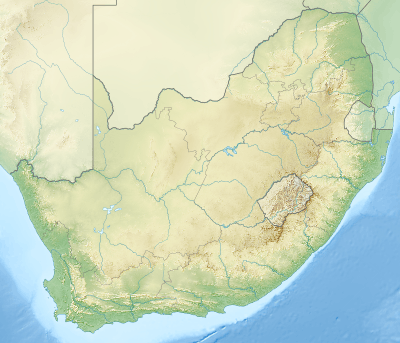Byneskranskop
Byneskranskop is an archaeological site in present-day South Africa where the coastal plain meets the southern Cape Fold Belt. Neolithic human remains have been discovered in caves at the site. Carbon dating of the remains indicates the bodies date from 3,000 to 2,000 years BCE.[1][2]
.jpg) Location map | |
 location in South Africa | |
| Region | South Africa |
|---|---|
| Coordinates | 34°36′37″S 19°26′15″E |
Remains of tortoises at this site and a dig at Die Kelders, have been used to assess a correlation between tortoise size and human population, with a decrease in tortoise sizes as the human population grows.[3]
166,000 stone artefacts were recovered from the site during the first dig. These were dated as far back as 12,000 years BCE. Pottery sherds were limited to the period of 250 years BCE or later.[1]
Gallery
_(17795444723).jpg) Front facing, AP6051
Front facing, AP6051_(17795446853).jpg) Lateral view, AP6051
Lateral view, AP6051.jpg) Stone flakes
Stone flakes.jpg) Diagram of burial locations, BNK3
Diagram of burial locations, BNK3
gollark: Send different Content-Type headers?
gollark: ???
gollark: That's more of a security thing than a privacy thing.
gollark: That's because you're worrying they might be leaked, isn't it?
gollark: I think this is at least partly because of the fear that they *might* be.
References
- Schweitzer, F. R.; Wilson, M. L. (December 1978). "A Preliminary Report on Excavations at Byneskranskop, Bredasdorp District, Cape". The South African Archaeological Bulletin. 33 (128): 134. doi:10.2307/3888150. JSTOR 3888150.
- Julien Louys, ed. (2012). Paleontology in ecology and conservation. Berlin: Springer. p. 245. ISBN 9783642250385.
- Klein, Richard G.; Cruz-Uribe, Kathryn (June 1983). "Stone Age Population Numbers and Average Tortoise Size at Byneskranskop Cave 1 and Die Kelders Cave 1, Southern Cape Province, South Africa". The South African Archaeological Bulletin. 38 (137): 26. doi:10.2307/3888212. JSTOR 3888212.
| Wikimedia Commons has media related to Byneskranskop. |
This article is issued from Wikipedia. The text is licensed under Creative Commons - Attribution - Sharealike. Additional terms may apply for the media files.